Click on images to enlarge
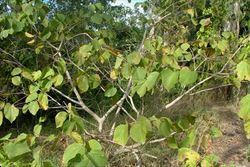
habit (Photo: Sheldon Navie)

older stems (Photo: Sheldon Navie)

close-up of bark on main stem (Photo: Sheldon Navie)

close-up of younger branch (Photo: Sheldon Navie)

broad, alternately arranged, leaves (Photo: Sheldon Navie)
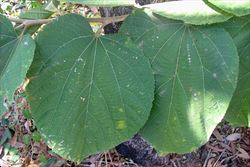
leaves (Photo: Sheldon Navie)
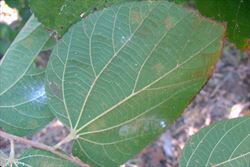
leaf undersides showing raised veins (Photo: Sheldon Navie)
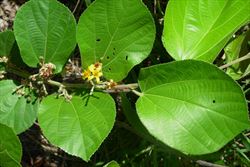
younger leaves and flower clusters (Photo: Chris Gardiner)

flowers (Photo: Chris Gardiner)

immature fruit (Photo: Chris Gardiner)
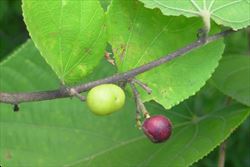
close-up of immature and mature fruit (Photo: Chris Gardiner)
Scientific Name
Grewia asiatica L.
Synonyms
Grewia subinaequalis DC.
Family
Tiliaceae (New South Wales, South Australia, Western Australia and the Northern Territory)
Sparrmanniaceae (Queensland)
Common Names
falsa, grewia, phalsa, phassa
Origin
Native to the Indian sub-continent (i.e. southern India) and south-eastern Asia (i.e. Cambodia, Laos and Thailand).
Cultivation
This species has occasionally been cultivated in the warmer parts of Australia. It was first reported to be naturalised not far from the Darwin Botanic Gardens, where it was beng cultivated.
Naturalised Distribution
This species is becoming widely naturalised in northern Australia. It was first recorded in Darwin, and has since become relatively widespread in the northern parts of the Northern Territory. It is also becoming widespread in the coastal districts of northern Queensland, particularly in the Cooktown/Laura district, and was recently recorded in the Kimberley region in northern Western Australia (i.e. near Kunanurra).
Naturalised overseas in the Philippines and on La Réunion in the Mascarenes.
Habitat
This species grows on most soil types in drier tropical and semi-arid areas. It is mostly a weed of open woodlands, grasslands, drier vine thickets, disturbed sites, riparian areas, the margins of lakes and coastal environs.
Habit
A shrub or small tree with a spreading habit that usually grows up to 4 m tall, but can sometimes reach up to 8 m in height.
Distinguishing Features
- a large shrub or small tree with a spreading habit (usually growing up to 4 m tall).
- its large almost rounded leaves are alternately arranged along the stems and have rough surfaces.
- these leaves are dull green above and paler underneath with serrated edges.
- its small flowers are bright yellow or reddish with numerous stamens.
- its round purplish-black fruit (up to 1 cm across) and usually covered with a whitish powder.
Stems and Leaves
The bark on the older stems is greyish-white or greyish-brown in colour and its long and slender branches are spreading or arching in nature. The younger branches vary from being smooth and hairless (i.e. glabrous) to densely covered with star-shaped hairs (i.e. stellate tomentose).
The leaves (10-18 cm long and 9-14 cm wide) are alternately arranged along the stems and are borne on short stalks (i.e. petioles) 13-15 mm long. They vary from being broadly heart-shaped (i.e. cordate) or almost rounded (i.e. orbicular) to oval (i.e. elliptic) or somewhat egg-shaped in outline (i.e. obliquely ovate). These leaves are dull green and hairless (i.e. glabrous) or roughly hairy (i.e. scabrous) above, while their undersides are usually densely and softly hairy (i.e. tomentose). The tips of the leaves are pointed or rounded (i.e. apices acute or obtuse) and the leaf margins are sharply toothed (i.e. serrate). The leaf blades have five obvious veins that spread outwards from the base (i.e. they have palmate venation), and these veins are raised on the undersides of the leaves.
Flowers and Fruit
The small flowers are arranged in clusters in the leaf forks (i.e. in axillary fascicles), each cluster having 2-10 branches (i.e. peduncles). Each of the branches (1.5-5 cm long) bears three to five flowers on short stalks (i.e. pedicels) 10-15 mm long. These flowers are bright yellow, or reddish-purple, and have numerous (50-100) stamens. Each flowers also has five sepals (7-12 mm long and 2.5-5 mm wide) and five smaller petals (3-10 mm long), which are both yellow in colour. Flowering occurs during winter and spring (i.e. from July to November).
The small fleshy fruit (5-12 mm long and 6-8 mm wide) are somewhat rounded (i.e. globular or ovoid) and look like 'berries' (they are actually drupes). These fruit turn from green to red and then purplish-black or dark brown when ripe, and their skins are often covered with a thin layer of whitish powder (i.e. they are pruinose). Fruit are present from late summer through to the following spring (i.e. from March to November).
Reproduction and Dispersal
This species reproduces by seed. The seeds are spread when they are ingested and expelled intact by birds and other animals. They may also be spread as ornamental plantings, in dumped garden waste, and by floodwaters.
Environmental Impact
Grewia (Grewia asiatica) is regarded as an environmental weed in the Northern Territory and Queensland. It is listed as a priority environmental weed in two Natural Resource Management regions. This species invades natural woodland communities, changing the structure and processes of the systems. It is thought to pose a significant threat to the biodiversity of the tropical savannas and rangelands of northern Australia.
Grewia (Grewia asiatica) is believed to be reasonably widespread in northern Queensland, with specimens being collected from the Collinsville, Townsville, Mackay, Ayr, Laura and Cooktown districts. It has has invaded woodlands in the drier parts of the Cape York Peninsula, particularly in the Laura-Lakefield area. In the Townsville region it grows in disturbed areas in eucalypt woodlands which are subject to frequent fires. At Laura, it grows in eucalypt and melaleuca woodlands or open forest and is particularly vigorous in riparian areas near the Laura River. Grewia (Grewia asiatica ) is listed as a high priority weed species in the Cook Shire and as a medium priority pest species in the Townsville City Council local authority area.
In the Northern Territory, grewia (Grewia asiatica ) is a significant weed in the Daly Basin region and is also present in the Finnis and Adelaide River catchments. It has also invaded conservation areas in northern Queensland and the Northern Territory (e.g. Casuarina Coastal Reserve).
Legislation
Not declared or considered noxious by any state government authorities.
Similar Species
Grewia (Grewia asiatica) may be confused several native grewia's (Grewia spp.), which are also found in the same regions of northern Australia. Most of these species have smaller and narrower leaves, or white flowers, but dog's balls (Grewia latifolia) is particularly similar. These two species can be distinguished by the following differences:
- grewia (Grewia asiatica) has large and very broad leaves (10-18 cm long and 9-14 cm wide) and flowers with small yellow or reddish coloured petals (3-10 mm long). Its fruit are normally borne singly and turn purplish-black or dark brown when mature.
- dog's balls (Grewia latifolia) has moderately large and relatively broad leaves (7-11 cm long and 2-8 cm wide) and flowers with very small yellow petals (3-4 mm long). Its fruit are normally borne in pairs and turn brown when mature.

